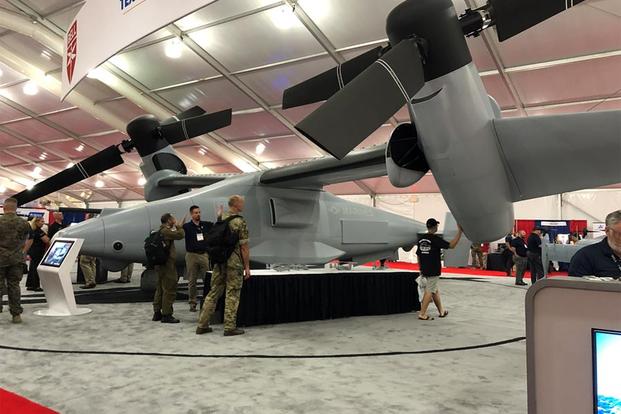QUANTICO, Virginia -- As the sea services prepare for potential fights against other big navies, the Marine Corps is considering using a massive drone not unlike its MV-22B Osprey to protect ships.
Commandant Gen. David Berger does not want his Marines being passive passengers aboard Navy ships. That has service leaders looking for ways Marines can help defend sea vessels from the moment they embark, Col. Kurt Schiller, director of the maritime expeditionary warfare division at Combat Development Directorate, said at the Modern Day Marine 2019 expo here Tuesday.
One tool under consideration is the Bell V-247 Vigilant, an autonomous tilt-rotor unmanned drone about the size of a Huey helicopter that can operate from ships and loiter in the air for about 10 hours.
A prototype of the aircraft, which looks like a smaller version of the Osprey, was on display for the second year during the expo. Jason Hurst, Bell's V-247 Vigilant program manager, told Military.com the aircraft is well-suited to protect sailors and Marines at sea as the services prepare to operate in more contested environments.
"This has the ability to provide organic electronic warfare capabilities that aren't on the [amphibious ships] today," he said. "Think of jamming, decoy [unmanned aerial systems] and other air-launched effects."
Related: Marines Release Specifications for New Mega-Drone
The V-247 is a contender in the Marine Corps' MUX program, which stands for Marine Air-Ground Task Force Unmanned Aircraft System-Expeditionary. The Marine Corps wants its large unmanned aircraft systems in the skies by 2026, and they should be able to operate alongside manned aircraft, provide air support, fly long distances and carry a full payload.
The Vigilant can do all of that, Hurst said. And since Marines are already used to operating the tilt-rotor Osprey, he added that it makes the V-247 a good fit for the service.
The Vigilant is equipped with sensors that could be used as an early warning system, which Hurst said also has the Navy eyeing the aircraft. The Navy is also interested in the drone's ability to send targeting information back to the ship.
"A lot of their focus has been [intelligence, surveillance and reconnaissance] with targeting so the ability to get sensors over the horizon and provide targeting information to the ship to help paint the picture," he said.
The V-247 can carry Hellfire missiles, torpedoes, jamming pods and air-to-air missiles. While it's still in the prototype phase, Hurst said Bell officials think they can keep the price around the Marines' target of $25 million.
"This would be the seventh tilt-rotor we have built, so a lot of our advantage is in the know-how and the proven technology we have both from the V-22 and its almost 500,000 flight hours, as well as the V-280 that we're using for our technology pipeline, which has amassed about 100 flight hours as a prototype for the Army Future Vertical Lift program."
-- Gina Harkins can be reached at gina.harkins@military.com. Follow her on Twitter @ginaaharkins.
Read more: Read all about Modern Day Marine 2019













